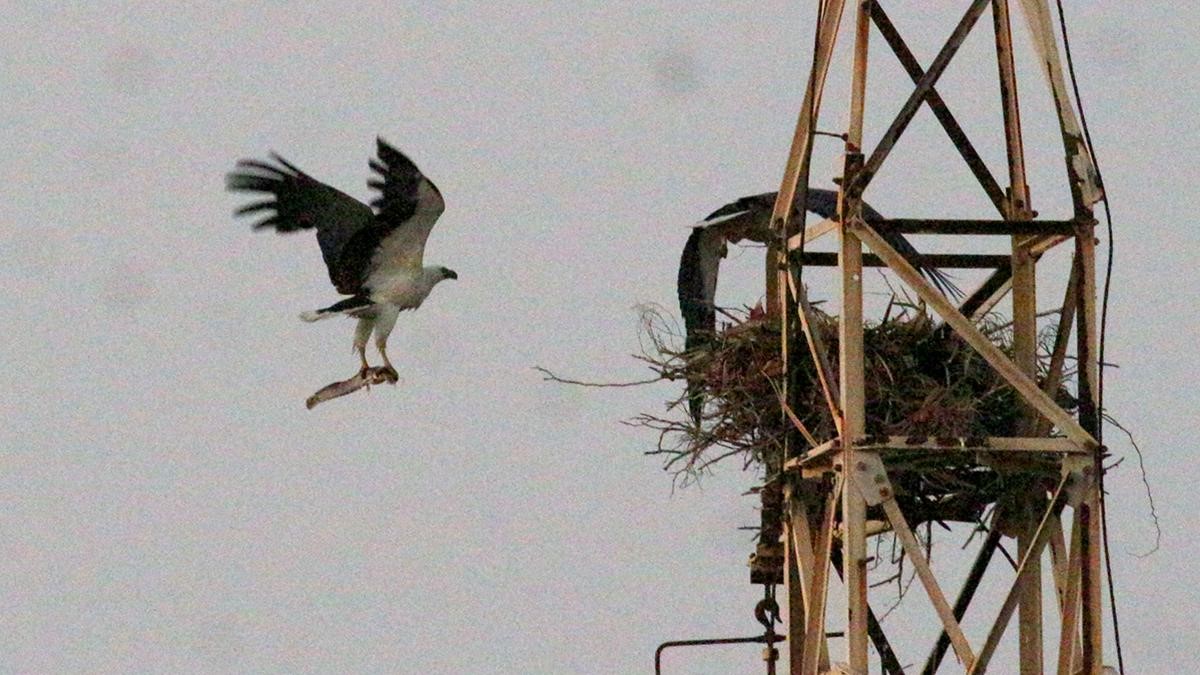Description

Disclaimer: Copyright infringement not intended.
Context
- The White-bellied Sea Eagles in India are displaying a new nesting behavior by choosing man-made structures such as power towers holding high-tension wires as their nesting sites.
- This adaptation has both potential risks and benefits for the eagles and the human population nearby.
- A study published in the Journal of Threatened Taxa highlights this emerging behavior and its underlying reasons, such as the scarcity of natural nesting alternatives like trees.
Details
Nesting Behavior on Power Towers
Strategic Nesting Sites
- The study observed White-bellied Sea Eagle nests on powerline towers located about 2 km inland from the sea in Ramanathapuram, Tamil Nadu.
- These nesting sites allowed the eagles to have an advantageous vantage point to scan the nearby marine area for potential food sources.
Natural Nesting Alternatives
- Historically, these eagles build nests in tall trees near coastal areas, tidal creeks, and estuaries.
- The use of power towers indicates a potential lack of suitable natural nesting sites.
Implications and Conservation
- The adoption of power towers as nesting sites by eagles has ecological implications, including potential interactions with power infrastructure and disturbances to the birds' natural behaviors.
- Proper management and monitoring of such sites are essential to ensure the safety of both eagles and nearby human populations.
.jpg)
About White-bellied Sea Eagle
- Haliaeetus leucogaster is a magnificent bird of prey that calls the coastal regions of the Indian subcontinent, Southeast Asia, and Australia its home.
- Known for its impressive size, powerful flight, and distinctive appearance, this sea eagle plays a vital role in maintaining the ecological balance of its habitats.
Physical Characteristics
- The White-bellied Sea Eagle is a large raptor, with a wingspan that can reach up to 2.2 meters (7.2 feet).
- Its plumage ranges from dark brown on the upperparts to a striking white on the head, neck, and underparts.
- One of its most recognizable features is its striking white head and tail feathers, which contrast with the dark body.
- The powerful yellow beak and legs further add to its distinct appearance.
Habitat and Distribution
- White-bellied Sea Eagles are resident raptors found along the sea coast of India, from Mumbai to the eastern coast of Bangladesh, Sri Lanka, and coastal south-eastern Asia to southern China and Australia.
- The eagles have a wide distribution range across coastal regions.
- These diurnal monogamous birds of prey mainly feed on sea snakes and fish.
- They are occasionally seen in inland waters along tidal rivers and freshwater lakes.
Conservation Status
- White-bellied Sea Eagles are currently classified as of "least concern" on the IUCN Red List of threatened species.
- Monitoring this changing nesting behavior and assessing its long-term impact on the eagles' population and behavior is crucial for their conservation.

Conclusion
The shift in nesting behavior of White-bellied Sea Eagles to man-made structures like power towers is a noteworthy phenomenon. Understanding the reasons behind this behavior and its implications is vital for maintaining the delicate balance between the eagles, their habitats, and the human environment. Proper management and conservation efforts are needed to ensure the safety and well-being of these majestic raptors and their ecosystems.
|
PRACTICE QUESTION
Q. Consider the following statements about White-bellied Sea Eagles (Haliaeetus leucogaster):
1. They are found exclusively in the Northern Hemisphere.
2. White-bellied Sea Eagles primarily feed on fish and water birds.
3. They have a distinctive white head and tail feathers, with a dark body.
4. These eagles are not known for their strong and powerful flying abilities.
How many of the statements given above are correct?
A) Only one
B) Only two
C) Only Three
D) All Four
Answer: B)
|
https://www.thehindu.com/sci-tech/energy-and-environment/coastal-raptors-make-power-towers-their-home/article67213651.ece
















